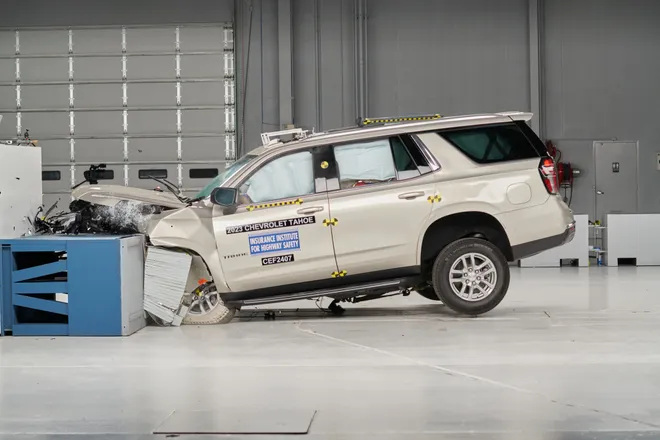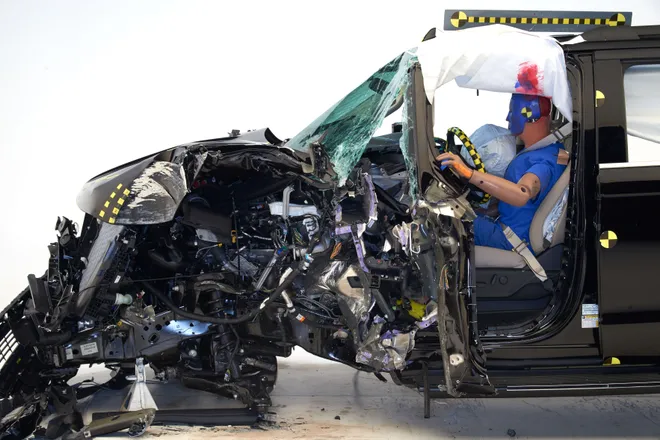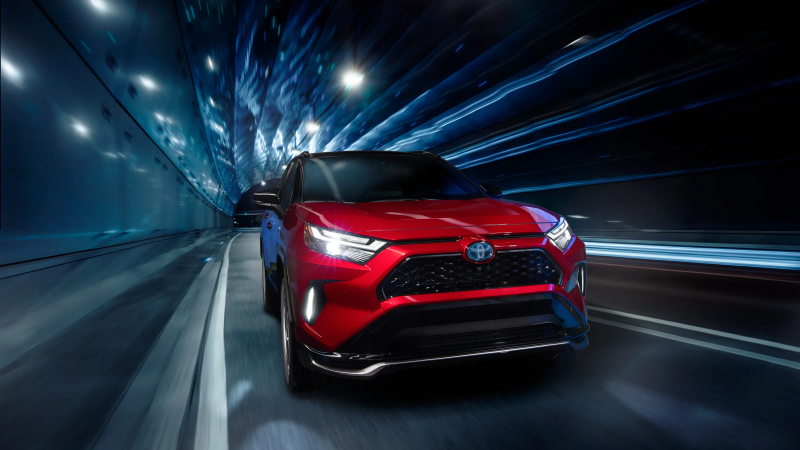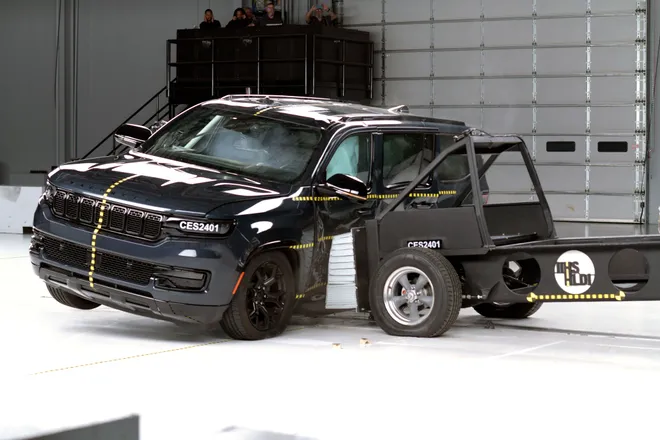Is my large SUV safe? Just 1 of 3 popular models named 'Top Safety Pick' after crash tests
- The Chevrolet Tahoe and Ford Expedition failed to qualify for the IIHS's 2024 “Top Safety Pick” award.
- The Jeep Wagoneer was the only one of the three large SUVs tested to be named a top safety pick.
- This was the research organization’s first time testing the three vehicles.
Two popular SUVs fell short of the Insurance Institute for Highway Safety’s safety standards after showing "subpar performance" in certain crash tests.
The results, announced Thursday, show the Chevrolet Tahoe and Ford Expedition failed to qualify for the insurance institute’s “Top Safety Pick” award this year. The Jeep Wagoneer was the only one of the three vehicles to meet the mark, although the IIHS says it, too, lacks “good protection” for backseat passengers.
This was the auto insurance industry-funded research organization’s first time testing the three vehicles, with results applicable to the 2023-2024 model years. More than 90% of new models have “sailed through” the evaluation with good ratings since 2021, according to a press release.
“These discouraging results show that some popular vehicles still lag behind in meeting the most advanced safety standards,” said Raul Arbelaez, vice president of the institute’s vehicle research center, in a press release. “The good news is that the top performer in this class proves that automakers can readily address these problems.”

How IIHS car crash testing works
The insurance institute evaluated two aspects of safety: crashworthiness, or how well a vehicle protects occupants in a crash; and crash avoidance, or technology that can prevent a crash or lessen the severity.
Evaluations include frontal crash tests, side crash tests, headlight evaluations, and crash prevision tests. Those that perform best qualify as a “Top Safety Pick."
Previously, the organization had avoided testing larger SUV models; vehicles need a stiff front end to pass frontal crash tests, but making the front of an SUV too stiff could make them more dangerous to other, lighter-weight vehicles in a crash.
However, the organization says things have changed. There are more heavy vehicles on the road today, with J.D. Power estimating that SUVs and trucks make up roughly 80% of new U.S. car sales. And electric vehicles, which weigh more than gas-powered cars, represent the fastest-growing car sales category with nearly 8% of the total U.S. vehicle market as of 2023, according to Kelly Blue Book estimates.
And large SUVs pose less of a risk to passengers in smaller cars than in years past, according to a 2019 report from the IIHS. The organization found that newer SUV designs are more "compatible" with lighter vehicles, meaning their bumpers and other energy-absorbing structures better align, reducing the likelihood of a car or minivan occupant dying when colliding with an SUV.
The IIHS website also notes that 52% of motor vehicle crash deaths in 2021 occurred in single-vehicle crashes.
Ford Expedition
IIHS found the Expedition’s structure did "not hold up" when testing crashes on either side. There was a high risk of injury to the driver’s right leg and moderate risk to the left, and the steering column partially detached from the instrument panel in the driver-side test.
The driver’s side curtain airbag for the backseat passenger failed to deploy during the test, but the insurance institute said that wasn’t enough to change the SUV's overall rating.

In a frontal crash test, “the barrier pushed into some of the vehicle structure, ripping some of it away and really compromising a lot of the safety cage,” Arbelaez said in a video shared with USA TODAY. “What this means is, for the driver dummy, you have less survival space. And in this test in particular, we saw elevated lower leg injury measures, which we never like to see.”
A statement from Ford says it is "always working to continuously improve" and considers third-party feedback in vehicle development, but notes that making changes to perform better in the IIHS's small overlap rigid barrier test could increase injury to occupants in other, lighter-weight cars during a crash.
The automaker also pointed out that the 2023 and 2024 Expedition meets or exceeds the National Highway Traffic Safety Administration's regulatory requirements, and it is the only vehicle in the segment to achieve a five-star overall vehicle score in the administration's New Car Assessment Program.
Chevrolet Tahoe
The Tahoe “really struggled” with the insurance institute’s headlight and pedestrian avoidance test, according to Arbelaez. The headlights offered poor visibility and glare issues, while the vehicle struggled with pedestrian avoidance during the nighttime test.
“Effective pedestrian collision avoidance systems are important for all vehicle classes, but for large SUVs like these, they are especially important because our research shows that when they strike pedestrians, they are more likely to cause fatal injuries,” Arbelaez said.

Testing a crash on the driver's side found a “substantial risk of lower leg injuries” to the driver, although airbags and restraints worked well. Hits to the passenger side performed worse, with a high risk of injury to the passenger's right foot and a moderate risk of injury to the left leg.
The dummy in the second row showed a high risk of head or neck injuries along with chest injury risks. The seat belt failed to stay put in the ideal position, which heightened the risk of abdominal injuries.
General Motors spokesperson Bill Grotz said the automaker is confident in the safety of the Tahoe, which achieved a four-star safety overall rating from the NHTSA's New Car Assessment Program.
“We value consumer metric ratings from IIHS and will look to incorporate these latest findings into our new vehicle designs.,” Grotz said.
Jeep Wagoneer
While the Wagoneer is a “Top Safety Pick,” IIHS said the vehicle did not earn the “Top Safety Pick+" award, the organization’s highest rating, because it fell short of protecting passengers in the back seat.
Arbelaez said the vehicle’s structure held up “much better” than the Expedition in a frontal crash test.

On a driver-side crash test, the SUV performed "slightly worse" compared to the frontal crash tests, with a modest risk of injury to the driver’s left foot and ankle.
“The Wagoneer shows us it is possible to get good performance in a large SUV," Arbelaez said. "We want the other automakers to take note and improve their designs."
"This recognition validates the dedication of our engineers, who integrated state-of-the-art technology in every aspect of the Wagoneer's design,” said Bill Peffer, senior vice president and head of the Jeep brand in North America, in a statement. “The combination of a robust body structure and a comprehensive suite of over 120 standard and available advanced safety features, helps create a secure environment for drivers and passengers."
Large SUV named as 2024 Top Safety Picks
According to the IIHS website, the large SUVs listed as 2024 top safety picks include:
- Audi Q7 4-door SUV
- Audi Q8 e-tron 4-door SUV
- Audi Q8 Sportback e-tron 4-door SUV
- Jeep Wagoneer 4-door SUV
- Rivian R1S 4-door SUV
Disclaimer: The copyright of this article belongs to the original author. Reposting this article is solely for the purpose of information dissemination and does not constitute any investment advice. If there is any infringement, please contact us immediately. We will make corrections or deletions as necessary. Thank you.







